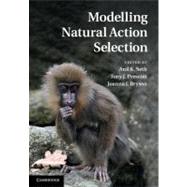
Note: Supplemental materials are not guaranteed with Rental or Used book purchases.
Purchase Benefits
What is included with this book?
| Foreword | p. viii |
| Preface | p. xi |
| List of contributors | p. xii |
| General introduction | p. 1 |
| Rational and optimal decision making | |
| Introduction to Part I: rational and optimal decision making | p. 7 |
| Do we expect natural selection to produce rational behaviour? | p. 12 |
| Optimised agent-based modelling of action selection | p. 37 |
| Compromise strategies for action selection | p. 61 |
| Extending a biologically inspired model of choice: multi-alternatives, nonlinearity, and value-based multidimensional choice | p. 91 |
| Bayesian approaches to modelling action selection | p. 120 |
| Post-retrieval inhibition in sequential memory search | p. 144 |
| Computational neuroscience models | |
| Introduction to Part II: computational neuroscience models | p. 169 |
| Action selection and refinement in subcortical loops through basal ganglia and cerebellum | p. 176 |
| Cortical mechanisms of action selection: the affordance competition hypothesis | p. 208 |
| Toward an executive without a homunculus: computational models of the prefrontal cortex/basal ganglia system | p. 239 |
| Hierarchically organised behaviour and its neural foundations: a reinforcement-learning perspective | p. 264 |
| The medial reticular formation: a brainstem substrate lor simple action selection? | p. 300 |
| Understanding decision-making deficits in neurological conditions: insights from models of natural action selection | p. 330 |
| Biologically constrained action selection improves cognitive control in a model of the Stroop task | p. 363 |
| Mechanisms of choice in the primate brain: a quick look at positive feedback | p. 390 |
| Action selection in social contexts | |
| Introduction to Part III: action selection in social contexts | p. 421 |
| Agent-based models as scientific methodology: a case study analysing the DomWorld theory of primate social structure and female dominance | p. 427 |
| An agent-based model of group decision making in baboons | p. 454 |
| Endogenous birth and death of political parties in dynamic party competition | p. 477 |
| On optimal decision making in brains and social insect colonies | p. 500 |
| State-dependent foraging rules for social animals in selfish herds | p. 523 |
| Index | p. 538 |
| Table of Contents provided by Ingram. All Rights Reserved. |
The New copy of this book will include any supplemental materials advertised. Please check the title of the book to determine if it should include any access cards, study guides, lab manuals, CDs, etc.
The Used, Rental and eBook copies of this book are not guaranteed to include any supplemental materials. Typically, only the book itself is included. This is true even if the title states it includes any access cards, study guides, lab manuals, CDs, etc.